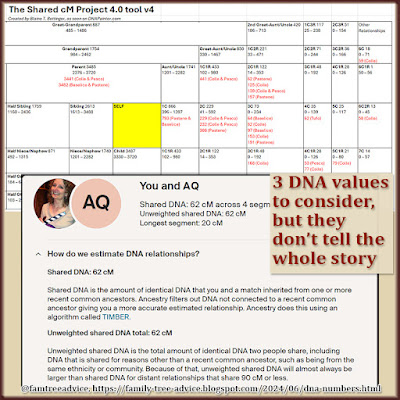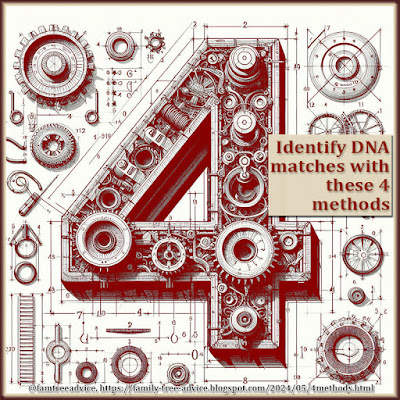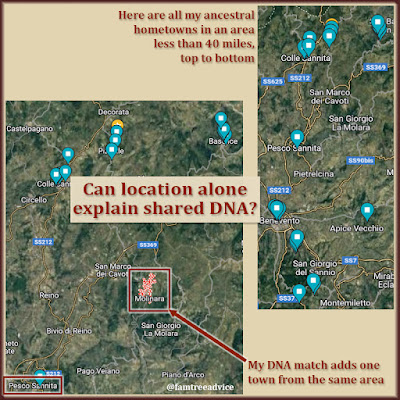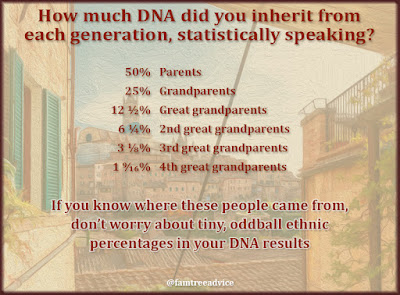The other day I found myself looking at Ancestry ThruLines® for the first time in a while. That's when I hit on a way to kickstart more growth in my family tree. I scrolled way down my list of direct ancestors to my 5th great grandfather. His name is Biaggio Trancuccio from Apice. That's the Italian ghost town whose vital records I've indexed so they're searchable.
Don't have an AncestryDNA test? MyHeritage has a similar feature. Choose Cousin Finder™ from the Discoveries menu. Find an interesting match and click View relationship.
What a pleasant surprise it was to find DNA matches among Biaggio's descendants. I have 2 DNA matches belonging to Biaggio's son, Giuseppe, my 4th great granduncle. I've already documented Giuseppe and his 9 children in my family tree. But I haven't looked into the marriages and descendants of the 9 kids yet.
 |
| Take advantage of these evidence-based line of succession genealogy hints. |
Thanks to ThruLines, I have some evidence of Giuseppe's direct descendants. I can use the names I see on ThruLines, search the vital records, and make my way down to these new DNA matches. Note that ThruLines shows these direct descendants based on other family trees. Maybe the builders of those trees have discovered more than you have.
Start With What You Know
In ThruLines, I see that my DNA matches descend from Giuseppe's son Angelo, my 1st cousin 5 times removed. I can use the town's vital records to find all his children. I'll start with the 1878 birth record of my matches' ancestor, another Giuseppe. His birth record tells me who his father Angelo married. Knowing her name is Teresa d'Oro, I can find the couple's other children.
Going through the vital records, I found 9 children for Angelo and Teresa. Later I'll document Teresa and her family, but first I'll look at ThruLines again. My DNA matches descend from Angelo's son Giuseppe and his son Salvatore. Salvatore and his siblings were born too late to be in the online Italian vital records. This would be the end of the paper trail, but one of the DNA matches doesn't have an Italian last name. There's a good chance I can find the family in U.S. records.
Jackpot! Salvatore was born in New York and is well-documented. That means his father Giuseppe came to America. The search results for Giuseppe are an absolute treasure trove. He came to New York in 1902, single. Census records from 1920 through 1950 show me his children's names. He married a woman called Florence.
 |
| Take advantage of a different kind of genealogy hint that puts you on the right trail. |
You've Got to Get Down to Climb Up
The real game-changer is the New York, New York Extracted Marriage Index. I see two mangled names with a 1911 Bronx marriage certificate number. At first glance, this seems to me to be Giuseppe Trancuccio and Fiorentina Frusciante. The transcription says Torentino Truscianti. But my knowledge of Apice names tells me it should be Frusciante. And Fiorentina is a common first name in the town.
I found the 1911 marriage certificate on the NYC Municipal Archives website. The clerk wrote Giuseppe's last name as Trangucci—exactly like the transcription. His birthplace is Apice, and his parents are Angelo and Teresa d'Oro. This confirms his identity. His wife's name, it's clear to me, says Fiorentina Fruscianti, born in Apice. Her parents are Sabato and Rosa Verginio.
With these details, I can climb cousin Giuseppe's Apice-born wife's family tree.
Turning to the Apice vital records, I found Maria Fiorentina Frusciante. She was born in 1893 to Sabato Frusciante (who is already in my family tree) and Rosa Virgilio. The last name Virgilio is not an Apice name, but it's clear she was there. She and Sabato Frusciante had 5 children besides Maria Fiorentina in Apice. Three of them married in Apice.
Be Ready to Pivot
So far, ThruLines looks correct. One of the DNA matches should be my 4th cousin twice removed, and the other, her granddaughter, my 6th cousin. I know exactly where they fit in my family tree. Now it's my job to use available records to prove it.
But something is off. ThruLines lists the older match (who died in 2017) as the daughter of Salvatore Trancuccio. Her obituary and her last name say otherwise. Evidence says she was the grandmother of the younger DNA match. But there's no connection to the Trancuccio name. Was the older match born out of wedlock? She came from the same New York borough as my Trancuccio clan, and she was born 5 years before Salvatore married.
She and I share 3 matches I've already connected to my 3rd great grandmother from Apice. I know we're related, but every record says otherwise.
She made it onto the 1940 census as an infant of 0 months. But there's a twist. The head of household is her mother. There is no husband listed, but there are 4 children, ages 7, 6, 5, and 0. In the 1950 census, my match's mother is a widow, but there's a new child who was born in 1943. The more I dug into this family, the less I understood.
In the end, I won't add these DNA matches to my family tree. I'll add notes to my DNA match list and drop the matter. If it is a case of misattributed parentage (I hate that phrase), I don't want to make any assumptions. But all is not lost. The leads generated by ThruLines have helped me expand my family tree and deepen my roots in the town of Apice.
Keep Expanding
Everything I found through this exercise gives me more leads to follow to expand my family in Apice. And it's all thanks to an Ancestry ThruLines line of succession from my 4th great granduncle. It would be easy to spend weeks harvesting these leads. And a lot of fun.














